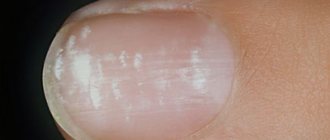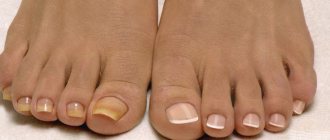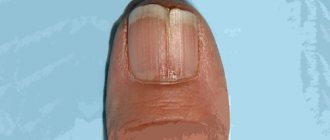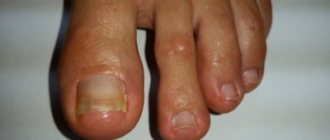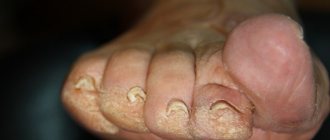Blackened toenails or Melanonychia is a change in the color of the nail to dark brown or black. It may be diffuse or have the shape of a longitudinal stripe.
This problem is quite common; almost every person has encountered it.
Darkening can be the result of a minor injury, but often black spots on the nails are harbingers of dangerous internal diseases. Darkening of the nail plate is not always painful. The problem may not cause physical inconvenience to its owner.
Benign longitudinal melanonychia can occur in patients of all ages, including children, and affects both sexes equally. Darkening of the nails most often occurs in people with dark skin, especially in people with Fitzpatrick skin types V and VI.
Blackening of the nail beds may be due to genetic disorders, injury, medications, nutritional deficiencies, endocrine disease, connective tissue disease, inflammatory skin disease, tumor or fungal infection of the nails.
The appearance of a black area and spots on the nails of the hands and toes: causes
Such a phenomenon as a black spot, which can appear under a transparent nail plate, is a fairly common occurrence. Moreover, almost every person with different hygiene habits and lifestyle can encounter it at least once in their life.
The reasons for this can be various cases: illness, injury. Such a spot can appear on both the fingers and toes. Of course, most often, this is how the fungus manifests itself, but you shouldn’t make hasty conclusions, because it can also appear in completely healthy people who have no complaints.
There are four main reasons that contribute to the appearance of an unpleasant stain on the nail:
- Presence of any fungus (disease)
- Predisposition or increased pigmentation
- Trauma to a finger or nail plate, resulting in a hematoma
- Liver problems and diseases in humans
Each individual case should be considered:
- Hematomas. This is probably the most common cause of stains on the nail. A hematoma is a bruise, simply put. At the site of the impact, blood accumulates, which is located in the soft tissues; it darkens over time and appears under the nail plate itself. This is easy to understand if you know how the nail itself is built. After all, under the plate itself there is quite soft tissue - the nail bed. These two tissues (skin and nail) are very closely related to each other. Upon impact, the capillary network of soft tissue is damaged. The vessels burst and hemorrhage occurs in the tissue. Such a spot does not have clear boundaries and its size depends only on the force of the impact. The blood darkens, acquiring a bluish, purple and black tint. Such a stain can disappear over time. It is often quite painful and produces unpleasant sensations when pressed.
- Increased pigmentation. This is not a common predisposition, but it does occur in some people. The reasons for this tendency to stains can be the consumption of poor quality water and food, direct ultraviolet rays, and even regular human work in harmful conditions. A characteristic feature of this predisposition is the periodic appearance and disappearance of dots. This happens because the blood pigment changes regularly. There is absolutely nothing scary about this, so you shouldn’t scare yourself about it. It is necessary to adjust your diet and lead a healthy lifestyle.
You should pay attention to such points only if they appear very often, do not disappear and have a very large-scale localization, that is, there are a lot of them. Such points may well have an oncological basis and be a symptom of cancer. If you have such concerns, consult your doctor for advice.
suspicious black dots on the nails may indicate the presence of cancer in the human body
- Liver problems and diseases. Such darkening of the nail plate can often indicate liver dysfunction. This happens because the organ ceases to cope with its duties, that is, it cannot cope with the processing of toxins. This is why dark and black spots appear on the nail plate in places. As a rule, such spots are usually blurry and do not have clear boundaries and sizes. They may appear and disappear periodically. In this case, you should seek help from a therapist who will prescribe tests for you. In no case should you postpone a visit to the doctor if, in addition to spots, you also notice pain in the liver area
- Fungus. The fungus often affects the nail plate of both the hands and feet. In this case, the nail can not only have black spots, but also completely change the color of its plate and become yellow, orange and even brown. Another characteristic sign of fungus is thickening of the nail plate and the appearance of unusual vertical stripes on the nail. It is important to know that after the nail is damaged, the soft tissues also begin to suffer. In this case, treatment should be started immediately as quickly as possible. Before choosing a medicine, consult a dermatologist if possible. He can order you an important series of tests, the results of which will determine your problems and help you choose effective treatment.
Thus, two main reasons can be distinguished for the appearance of black spots on the nail - external (impacts and tissue damage) and internal (diseases of organs and tissues).
black spots on the nail plate, on the toe
Stages of the disease
The classification of nail melanoma involves (like any other cancer) several stages:
- zero (in situ). At this stage, non-invasive damage by malignant cells is detected;
- first. The thickness of the formation is either up to 1 millimeter or up to 2, but without ulceration;
- second. It is placed if the thickness of the tumor is no more than 2 millimeters or no more than 4, but without ulceration;
- third. It is placed regardless of the size of the melanoma itself, provided that metastases are detected in the regional lymph nodes;
- fourth. Suggests the presence of metastases in internal organs.
Obviously, the lower the stage, the higher the patient’s chances of effective treatment and longer life expectancy.
Blackened nails on the big toes and on the hands of men and women, reasons
The most common cause of a blackened nail is hemorrhage under the nail plate, which occurs as a result of a finger injury.
The most common injury is the big toe. It is quite active and differs from others in its size. In this case, if there is a bruise and hemorrhage, pain may be observed over the next two weeks when walking, putting on shoes, or pressing on a finger. Pain may accompany the finger until the damaged nerve endings reach complete death.
Pay attention to the nail after two weeks. If the pain does not go away, and the finger has increased in size (swelling), you should immediately consult a doctor.
The cause of blackening of a large nail (like any other) can be microsis. Microsis is a disease that is easy to catch in public places where you have bare hands contact with the floor, handrails, and benches. For example: bathhouse, sauna, public shower, toilet, locker room, and so on. In such places, a person with a disease leaves it on the surface, where it is picked up by a healthy person. Unfortunately, it is almost impossible to cure microsis on your own, because in order to determine the cause of the fungus, you need to undergo many tests.
Myrosis of the nail plate on the big toe
Other reasons for changes in the color of the nail plate:
- A black nail that has a slightly greenish tint is often a symptom of an abnormal and unhealthy gastrointestinal tract.
- A black nail with a slight bluish tint indicates that a person has problems with blood circulation
- A black nail with brown and burgundy shades may indicate disorders of the central nervous system and problems with the brain.
Another common cause of blackened nails on both the fingers and toes is hemangioma.
Hemangioma is a disease that causes the growth and subsequent darkening of blood vessels in the soft tissues under the nail plate. In addition, it causes unbearable and very noticeable pain. In some cases, it appears even before the nail turns black. Hemangioma is a kind of tumor under the nail, which can also be felt by pressing. If the dark color of the nail plate turns white, this is a clear symptom of the presence of a neoplasm.
nail hemangioma: A - dark stripe, B - dark spot
Pay attention to how you feel. If, in addition to pain, you regularly feel discomfort, this is a signal that there is strong pressure under the nail. In such situations, you cannot do without the help of doctors. The doctor will recommend removing the nail plate and only then performing a series of treatment procedures. If the nail is removed, you can perform all the necessary manipulations, get rid of the tumor and eliminate the pain. As a result, the dead nail is replaced by a new healthy one.
Not only drug treatment, but also a healthy diet, as well as regular salt baths will help speed up the healing process.
Complications and prognosis
With the development of nail melanoma, the risk of metastases is very high. As a rule, they appear in the liver and lungs. However, resection does not protect 100% from these processes.
Another difficulty is that surgery always (but to varying degrees) reduces the functionality of the limb. Patients also experience psychological difficulties, since their lifestyle changes, and in the case of hand operations, difficulties arise with the perception of their new appearance, which is difficult to hide from others.
In the absence of metastases, the five-year survival rate of patients is about 60%, but if metastases are already present, the average survival rate ranges from 7-8 months. The specific timing depends on individual characteristics, as well as the size, thickness of the tumor and other factors.
Why did tight shoes turn my toe black?
If the nail turns black not from internal reasons, that is, problems with the health of internal organs, then from external ones. The nail can also turn black due to impaired blood circulation. This can happen when a person wears shoes that are too tight or uncomfortable. As a result, the finger is slightly injured and turns blue due to hemorrhage.
After the cyanosis goes away, the blood coagulates and it is for this reason that blackness appears under the nails. If the resulting hematoma is not too large in size, then it does not require any intervention and can resolve on its own over time. If the spot is large enough and occupies the entire nail plate, this means that blood circulation in the damaged vessels on the finger is completely disrupted.
Most often, this process ends with the rejection of the broken, damaged nail. After the diseased nail is rejected, a whole healthy plate should grow back.
black nail due to wearing tight shoes
To alleviate your condition and allow the nail to recover, you need to provide comfort to your finger. Avoid shoes that are too narrow and uncomfortable. Shoes should not be narrow, not tight, and should not rub. It is advisable that shoes be made from natural and high-quality materials.
You should also be careful about your lifestyle: avoid traumatic situations, do not engage in active sports during the healing period of the finger, eat healthy food that contains a sufficient amount of calcium.
Preventive measures
To prevent black nails from appearing again in the future, you should follow simple preventive rules. These include:
- Wear comfortable shoes of your size. It should not rub or squeeze your fingers. Often the nails on both thumbs or on one big toe turn black precisely because of this pressure. If possible, order shoes directly to fit your feet.
- Use protective coatings on your nails when doing a pedicure.
- Change your socks often.
- Do not try on or wear someone else's shoes.
- Wear rubber slippers in the pool or sauna to avoid getting a fungal infection.
- Drink vitamin complexes to strengthen your nails.
- Clean your home using disinfectants, especially in the bathroom.
- Follow safety precautions when playing sports, try to avoid injuring your fingers and nail plate.
Blackening of the nail is a phenomenon that requires urgent action. If it was caused by injury, the condition can be alleviated by resorting to first aid, aloe compresses and baths. But when blackness is formed due to diseases of the internal organs, only a specialist can determine how to treat it. Don’t let this condition start, and in the future, remember about prevention and proper care of your feet.
Why does the nail turn black in diabetes?
Diabetes mellitus is a disease that can affect the integrity and health of nails, both on the hands and feet. Why is this happening? Most often, the plates on the lower extremities are damaged due to the fact that blood circulation in the body and in the legs, in particular, is impaired. This can also happen when infected with a fungus. The fungus, which can be present on the nails of a healthy person for any reason, does not spread as quickly as on the nails of a person with any form of diabetes. Also, microbes, which are the main causes of fungal disease, can very actively spread throughout the entire foot of a diabetic and to soft tissues in particular.
It is not difficult to recognize and distinguish the fungus - the nail plate not only changes its color and turns black, the nail becomes thicker and denser. Often it starts to flake.
The fungus often affects the nails of people with diabetes because their metabolism is impaired. Diabetics are also distinguished by the fact that, along with the fluid, their sweat glands secrete glucose, which is very favorable for the development of fungus.
how diabetes can affect diseases associated with blackening of the nail plates
Another problem for people with diabetes is frequent ingrowth of nail plates into soft skin tissue. Such a nuisance occurs for the same reason - impaired circulation in the body and outflow of blood in the legs. Inconvenient, non-compliant shoes significantly aggravate the situation, allowing this process to happen faster. As a result, the finger swells, turns red and a hematoma forms.
In this case, you should definitely seek help from a doctor. If ignored and left untreated, the ingrown toenail will cause soft tissue infection and allow the toe to fester. In the worst case scenario, the plate or even the affected finger will need to be removed. This phenomenon is called “diabetic foot” syndrome.
Diagnostics
Diagnosing melanoma under the nail is not so easy, because it is often similar to other diseases or problems, for example, subungual hematomas. To exclude simpler situations and make an accurate diagnosis, doctors use dermatoscopy (examination of tissue under high magnification), as well as epiluminescence microscopy. The latter method involves examining changed areas of tissue in a special environment. Thanks to it, it is possible to distinguish a benign disease from a malignant one.
Cytological studies are carried out, but a biopsy in this case is undesirable, since it can provoke the development of metastases. Additional tissue examination is carried out after surgery, when the tissues are removed.
If nail melanoma is not excluded after examination, marginal resection of the nail is performed followed by tissue examination. When the diagnosis is confirmed, the patient is indicated for radical surgery.
Additionally, the following research methods are used:
- Ultrasound;
- CT;
- MRI.
They are needed to verify the presence or absence of metastases.
Why did the nail turn black after being hit on the arm and leg or if it was pinched?
Household nail injury is a common problem. This can easily happen to both fingers and toes. Toes most often suffer from impacts with furniture, and fingers can be pinched in doorways, windows, or simply hit with a heavy object.
Most often, the first pain from such an injury is very strong and sometimes unbearable. It is sharp, bursting and can even put a person in a state of shock. The pain occurs because the blood vessels of the soft tissues burst and hemorrhage occurs directly under the plate, the blood coagulates and turns black.
Such an injury should not be ignored, but should be treated immediately to reduce the hematoma and reduce pain.
How to reduce pain when a finger is injured and reduce a hematoma:
- First of all, quickly applying cold to it will help to weaken the hematoma in the first couple of days: ice, a cold bottle, dipping in cold water, snow
- You should keep an injured finger in the cold for no longer than fifteen minutes, so as not to make it worse
- This application of cold will constrict the blood vessels and thereby reduce hemorrhage, as well as at the same time reduce pain
A severe hematoma under the nail plate with profuse bleeding can burst the nail from below, lifting it. This rejection of the nail plate is quite painful. Only a surgeon can help in such a situation, who, using a sterile instrument, makes a hole in the nail and releases blood through it before it has a chance to clot.
This surgical intervention will help to avoid the death of the nail; in no case should such manipulation be done using improvised means or on your own in order to avoid unpleasant consequences and blood poisoning.
finger injury, blackened nail
Disease prevention
Prevention of subungual melanoma can include:
- protection of fingernails and toenails from physical and chemical injuries, exposure to aggressive chemicals;
- additional examinations of those people who have had cases of melanoma among their close relatives;
- monitoring existing benign neoplasms (nevi) and their timely removal.
Also, do not ignore the primary signs of melanoma of the nail plate. In many cases, they talk about other, simpler symptoms or diseases, but you shouldn’t count on it.
Why does my toenail turn black and hurt?
A sore toenail or fingernail has several causes:
- Traumatic nature. Depending on the bruise, you should choose the right effective treatment to get rid of unpleasant symptoms and eliminate pain
- Fungal nature - requires mandatory treatment with antifungal and antiseptic agents
- As a consequence of disruption of the internal organs, a full examination should be carried out to determine the presence of problems and diseases in the body
If the blackness of the nail is accompanied by unpleasant pain, this indicates that the integrity of the soft tissues has been compromised. In such cases, it is impossible to do without the intervention of doctors. If you do not intervene, the situation may worsen and lead to tissue suppuration.
the nail hurts, problems with nails due to bruises and fungus
Traditional methods
If the reason why the nails suddenly darkened is due to external factors, it is allowed to use time-tested alternative medicine. In case of extensive internal diseases, such measures are useless, and delay can cost the patient his life. Below are those folk remedies whose therapeutic effect has been tested in practice for more than a decade:
- In case of an infectious process with a risk of suppuration, it is recommended to crush the leaves of yarrow and plantain, and then wrap the resulting pulp with a bandage to the big toe. Perform the procedure at night, do not remove the bandage until the morning.
- If your big toe nail turns black, you need to combine 1 cup of turpentine, 30 g of crushed laundry soap, 50 ml of lamp oil, a few drops of medical alcohol and camphor oil. Mix, store in the refrigerator, and use as directed.
- Prepare fresh Kalanchoe juice from the leaves, lubricate the damaged nail with the composition overnight, repeat the procedure until the alarming symptoms completely disappear. It is advisable to wrap your thumb with a bandage after treatment.
Why does my toenail turn black and come away from my finger?
If you have a finger ear injury, it is quite possible to expect hemorrhage due to rupture of blood vessels. This blood enters the soft tissue, where it coagulates and forms a dark spot. Often the bruise is so severe that it provokes the appearance of a tumor.
This tumor bursts the nail plate and causes it to rise, while “giving” the person very unpleasant painful sensations. The finger tries to tear off the affected nail, which by this time may become rough and flake. It should not be pulled out under any circumstances.
The nail that grows over time should be carefully cut off with nail scissors, avoiding pain. Over time, the damaged nail will be replaced by a whole new layer and the finger will recover; this is a completely natural process.
nail plate rejection
Medicines for the treatment of black nails after injury
The healing process of soft tissues and nail plates damaged by bruises or pinching is delayed for a long time: the growth of a new healthy nail occurs in six months, or even a year. Throughout this period, it is necessary to protect the wound surface of the epithelium from the penetration of various types of infectious agents :
- pathogenic bacteria,
- viruses,
- fungi,
- protozoa.
Why does the nail turn black and not hurt?
Quite often it happens that the fingernail turns black, but does not give the person any painful sensations. Most often, this phenomenon is observed on the big toes of the lower extremities. And it often happens that people simply ignore this problem: men wear closed shoes, and women cover them with a layer of varnish. But this is far from a way out of the situation.
Several factors can affect the darkening of the nail:
- External influence: uncomfortable shoes, mechanical damage, trauma or bruise
- Internal effects: fungal infection, the presence of a benign tumor, disruption of the functioning of internal organs
If the nail turns black as a result of an injury, it’s not a big deal. As a rule, such a bruise does not cause any harm to the body. If the nail turns black as a result of a serious illness, you cannot do without the help of doctors.
Causes of blackened nails
Changes in nail color can be due to various reasons:
- traumatic hemorrhage,
- fungal infections,
- liver diseases,
- heart and respiratory failure,
- oncological tumors.
If the blackening of the nail is caused by damage to the finger, the victim must be given emergency assistance using the method of treating bruises .
In other cases with an unclear etiology, you need to immediately visit a doctor.
| Self-medication of a black nail with ointments, poultices, decoctions on the advice of a friend (neighbor) is unacceptable, this can cause irreversible consequences: sepsis, gangrene, atrophy of muscles and internal organs of the body. |
What to do if the toenail turns black, how to treat it?
Most often, after an injury, the fingernail or toenail turns black. It is not always possible to see a doctor on time. For this reason, you should definitely know the therapy that you can do for yourself:
- If your finger is injured, give it rest, stop moving it or walking if it is on your leg
- Raise your leg above your head to ensure normal blood circulation
- Until the finger gets rid of blackness and pain, you should provide it with loose shoes
- Apply a soft bandage to your finger to protect it from repeated injury. Use a bandage or adhesive tape
- Try not to handle the affected finger, especially if your household activities involve water or chemicals (wear gloves)
- Immediately after you receive a bruise, it is recommended to treat the nail and apply ricinol emulsion to it, which can stop bleeding and slow down the inflammatory process, accelerating the regeneration of soft tissues
- A few days after the injury, choose an anti-inflammatory ointment for your nail and finger for faster healing (arnica or heparin ointment). The medicine should be applied three times a day
- In order to relieve swelling of the finger and eliminate severe pain, you should apply a compress with dimexide to the bruised nail and finger. The compress should be done daily, preferably before bed, leaving the soaked gauze on the sore spot for at least half an hour
The most common thing - badyaga - will help you cope with the blackness under the nail and eliminate the pain. You can buy it at a pharmacy for a reasonable price. It is sold in powder form, which is diluted with water. The resulting mass is applied to the sore spot. If you do not have the opportunity to see a doctor, regularly lubricate the nail with bodyagu and gradually cut off the affected nail with scissors as it grows back.
You should understand that you should never tear off your nail - this can disrupt the natural rejection process and lead to infection. Tearing off part of the nail prevents the renewal of the entire nail plate.
Pay attention to how your finger perceives the treatment. If the inflammation does not decrease, but on the contrary becomes larger, the finger and the area around the nail turns red - the situation may worsen. It is quite possible to get purulent inflammation. In this case, you should stop any treatment and seek help from a specialist in the hospital.
Anesthesia
The doctor will determine which medications are necessary for an individual patient; here is a list of the most popular medications for the treatment of black nails:
- Compresses to reduce pain are made using an aqueous solution of Dimexide (2 times a day for 30 minutes), Novocain.
- They use anti-inflammatory painkillers: Analgin, Ibuprofen, Nise, Ketanov.
- Diclofenac, Ibuprofen, and Troxevasin ointments have anesthetic properties.
Anti-inflammatory and regenerating agents
- Relieve swelling and promote resorption of hematomas: Heparin ointment, Riciniol, Troxevasin. Herbal ointments Bodyaga Forte, Comfrey, Calendula.
- Cooling ointments with Menthol and Arnica are used to prevent the formation of hematoma and swelling immediately after a bruise.
- To activate tissue restoration, spray (or gel) Panthenol, Bepanten, Solcoseryl are used.
- When tissue inflammation occurs, doctors recommend lubricating the finger with Levomekol ointment and Ketonal cream.
What to do when a black nail plate peels off
If it is not possible to visit the surgeon’s office, the following safety measures should be taken:
- carefully trim off the plates extending from the nail bed,
- protect the wound with a bandage,
- disinfect the surface of injured tissues two to three times a day,
- lubricate with anti-inflammatory ointments.
Gradually the nail will come off spontaneously.
Forced removal will be required if the finger becomes infected and an inflammatory process begins.
